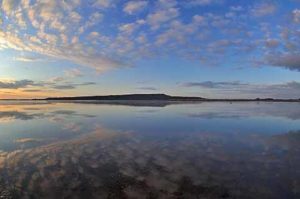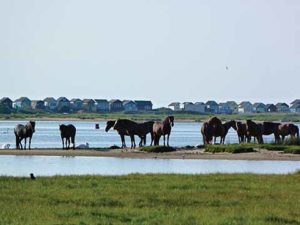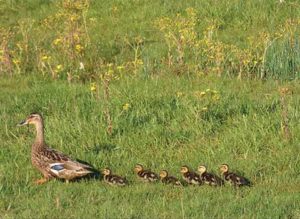Variety is the spice of life
The habitats and animals that live on and around Stanpit Marsh
Published in November ’17
For a place with a 7000-year history of human activity, Stanpit Marsh often has a wild, or at least untamed, look, in part thanks to its variety of habitats of marshland; reedbeds; salt-pans, creeks & streams; mud-flats and harbour waters; scrub and the high ground of Crouch Hill.
The outer eastern areas of the marsh are composed of closely grazed dense turf, while to the west the freshwater marsh consists of a wider variety of flowering marshland plants. Grazing is an important feature of the Marsh, keeping grasses in check and enabling a stronger growth of flowering plants. Grasses, together with aquatic vegetation, including algae left after receding flood tides, provide food for a variety of wildfowl. Gulls, herons and waders feed on amphibians, insects and worms, which might also be found in this habitat.
The reedbeds on Stanpit Marsh are composed mainly of the Common reed [Phragmites australis]. Other plants may be present, particularly around the edges. Reeds are a familiar sight along Purewell Stream, at Great Spires, bordering the upper parts of Mother Siller’s Channel, and in the north east area of the Marsh.

Stanpit is a place for sumptuous landscape shots – like this one of Hengistbury Head – as well as a wealth of wildlife
Patches of open water and ditches often occur amongst the reedbeds. The flowering heads, leaves, stems and root systems as well as the water, mud and detritus surrounding them, provide a great variety of habitats for animals.
Salt-pans and creeks are a feature of the Marsh. Their brackish water levels vary extensively according to the state of the tide and the amount of rainfall.
Both water and mud provide a rich habitat for small fish and invertebrates such as worms, crustaceans, insects and molluscs. All these animals in turn, are a plentiful source of food for egrets, herons, ducks and waders.
Purewell Stream is fresh water where it enters the Marsh and supports a different range of small fish and invertebrate species from those found in brackish water. These animals, in their turn, attract a different variety of birds including Kingfishers. The stream also provides freshwater for the ponies and cattle which graze the Marsh.
The mud-flats at low tide, especially the area known as Stanpit Bight, attract large numbers of feeding birds. Waders, ducks and gulls are supported by the rich supply of small invertebrates living in the mud. The waders are beautifully adapted with their varying beak lengths to take advantage of all the feeding opportunities available at differing depths within the mud. The harbour waters are rich with fish and crustaceans. Herons are often seen feeding on fish and crabs in the shallow waters, while cormorants and terns dive for fish in deeper waters. Aquatic vegetation provides food for swans and ducks.
Crouch Hill, the highest point on the marsh, is a fairly open area scattered with gorse bushes. The dry, sandy, acid soil encourages the growth of short fescue grasses and small species of clovers, chickweeds, trefoils and sheep’s sorrel. It is well grazed by rabbits and ponies. Such areas are known as ‘acid grassland’ and are relatively rare. There has been some cutback of the gorse associated with a relocation of Natterjack toads to the marsh [a Biological Action Plan Project] and the creation of artificial, temporary pools for spawn and tadpole development. The reduction of the gorse also aids acid grassland regeneration.
The scrub on higher sandy areas of the marsh, consists of several habitats. It comprises small trees such as holly, hawthorn and rowan, and thick patches of bramble, gorse and honeysuckle. These are interspersed with open areas of acid grassland, pools and bog. Together with flowering plants, this diversity of vegetation and habitat attracts an abundance of wildlife.
In autumn, South Marsh, in particular, is a patchwork of colour as glasswort in the damper areas begins to redden. High spring tides often completely flood the Marsh, making it quite inaccessible. As these floods recede, worms and other invertebrates which have come to the surface provide a plentiful food supply for waders and gulls. The tide strand line of dead reeds and other vegetation also harbours insects and crustaceans such as Sandhoppers.
After a flooding high tide, sea lettuce [ulva] and enteromorpha also litter the marsh.
Many lapwings that have spent the summer rearing young in local fields, return to the marsh. coots can also often be seen in groups grazing the grassy peninsulas with other water birds. Herons and little egrets are a familiar sight feeding in the pools and creeks, as well as the resident teal, Britain’s smallest duck. Young herons may be seen in close proximity to one another whilst learning feeding skills. Redshanks, and the semi-migrant greenshank might also be seen. At high tide, these and other resident birds may be feeding on insects, and other invertebrates within the marsh turf. The marshland peninsulas provide undisturbed roosting areas for the birds during high tide. These areas are vital during the latter months on the year, when energy must be conserved for the body to withstand the colder weather.
During the autumn the large, branched purple panicles of the reeds droop to one side and become a mass of silky down, made up of long hairs attached to seeds which are dispersed by the wind. Slowly the reeds die back as the leaves break away and the stems become pale and brittle. Breakdown and decay of this material provides a protective and fertile feeding layer (litter layer) for worms, crustaceans and insects.

Perhaps the defining image of Stanpit Marsh is the sight of ponies grazing with the beach huts of Mudeford Spit in the background
The reeds survive the winter with the help of oxygen which diffuses through the remaining hollow stems. These act as airways to the long, creeping root systems in the mud below. The hollow stems also provide a protective habitat for overwintering animals such as woodlice, earwigs, spiders and the larvae and pupae of wainscot moths.
The reeds continue to provide cover for a number of birds including reed buntings, ducks, coots and herons. Aquatic vegetation, including the algae, dies back in autumn. As decay proceeds, a rich layer of organic matter is produced, providing plenty of food for detritus feeders such as shrimps.
Many aquatic animals become relatively inactive as the temperature falls. Some, such as dragonfly and damselfly nymphs spend the cold months on the bottom while others, including ragworms and corophium, burrow deep in the mud. Some, including pond skaters, leave the water to lay eggs and survive the winter on land. Others, such as shore crabs and prawns, move into deeper water which is warmer than the Marsh creeks and pans. Small fish shelter in water around the bases and roots of aquatic plants.
Birds such as herons, egrets, curlews, redshanks, greenshanks and gulls may have to search and probe the mud more deeply for their prey. However, as this food source is relatively inactive there will be plenty to eat.
Teal return to the marsh at the end of the breeding season. They also feed in the pools, but are surface feeders.
Gulls and waders change to their winter plumage at this time of the year – the larger Herring and Black-backed gulls having a speckled appearance to their head feathers. But more noticeable is the change in the Black-headed gulls, which lose the majority of their black head feathers, retaining just a few behind the eye. The tawny-coloured young gulls now form small groups, as they learn to fend for themselves. Oyster-catchers develop a white throat band in
the winter.
Outside the breeding season, from autumn onwards, swans tend to be more tolerant of each other and form small flocks in the harbour. Swans that may have nested further up-river, return to the estuary with their young. Cormorants are a familiar sight in the estuary. They can be seen roosting, and drying their wings, on the grassy peninsulas and distant Blackberry Point.
In autumn, salmon, which have been maturing out to sea, travel through the harbour and up-river to spawn. Sea trout migrate into rivers in early autumn to spawn. The young may spend a year or more in the estuaries and creeks before migrating out to sea. Eels, having reached maturity up-river, pass through the estuary and out into open seas en-route to spawning grounds in the mid-Atlantic. Young mullet and flounders return to the sea in late autumn to find deeper, warmer waters for
the winter.
Adult grasshoppers and most crickets cannot survive the winter. Their eggs, which are laid in the ground during the summer, will overwinter in
this state.
A few spiders can actually survive the winter in the adult form, their bodies containing a variety of ‘antifreeze’ substances. But most orb-web spiders die. The next generation survives the winter in egg-sacs, either as eggs or spiderlings. Decaying leaf matter and logs provide ideal cover for insects and other animals that overwinter in the adult form. Frogs, toads and snakes may take advantage of rabbit burrows in which to hibernate.
• This piece is abridged from an article on the Friends of Stanpit Marsh’s website,
www.friendsofstanpitmarsh.org.uk
Credits:
pic 1 Flickr.com/Sue980
pic 2 & 3 David Cross
pic 4 Matt Northam
pic 5 & 6 Belinda Fewings





